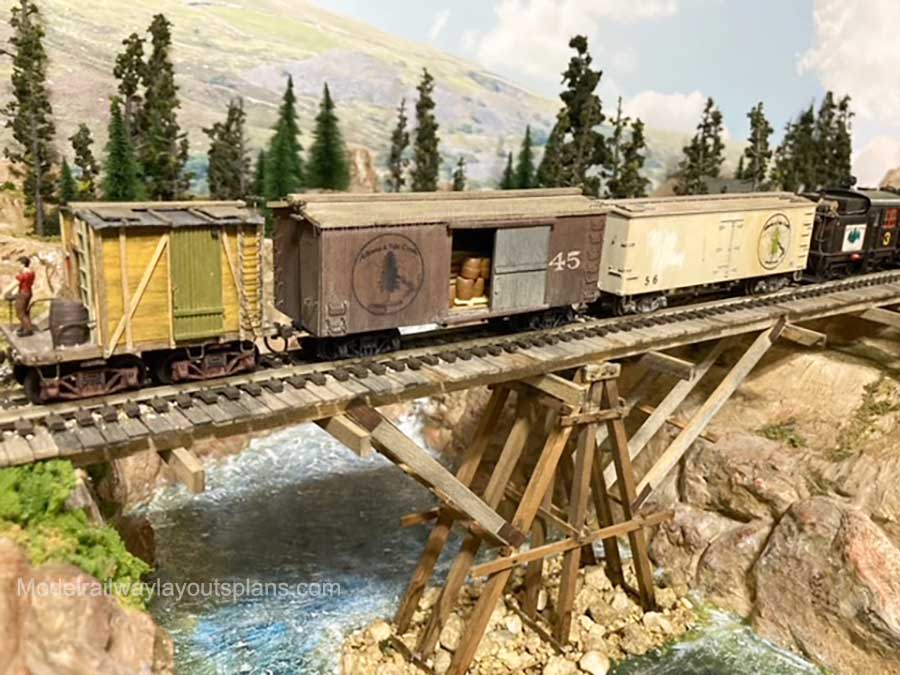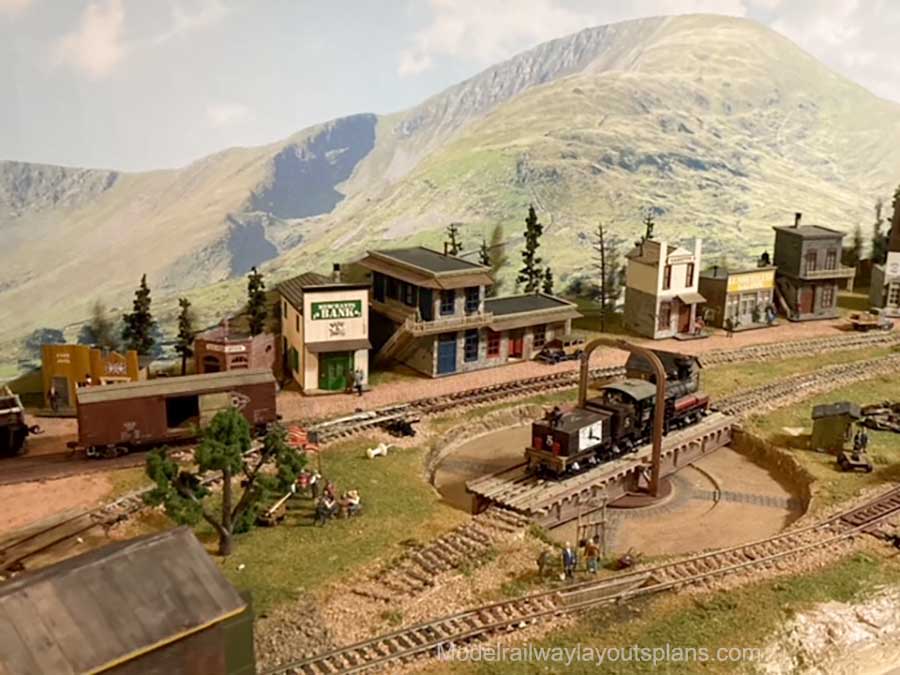Al’s been in touch with his HO model train log cars.
It’s a stunning layout and I’m really hoping Al can send us some more pics and details because I absolutley love it:
“I look forward to your site every morning. This is a fantastic hobby and it is so nice to see what others are doing, the ideas are almost endless.
I model in HO and have been working on the AT&C for several years, it is my fourth layout and keeps me out of trouble with the better half.
I am sending along a few pictures of what is done so far, as we all know a layout is never truly finished.
It is freelanced and based in the early part of the twentieth century. I have more photos of the construction from the beginning if interested. Keep up the good work.
Al”
A big thanks to Al for sharing his HO model train log cars layout. It’s a really popular theme, and it’s not hard to see why: they look great!
I thought it would be fun to list some of the them, so here you go:
HO logging layout plans (A different Al!)
Model railroad logging layouts
There’s lots more model train log posts on the blog, but these are certainly the ones that stick out for me.
Please do let me know if you’d like a long, long list of them all!
That’s all for today folks.
Please do keep ’em coming.
And if today is the day you poke boredom in the eye and join in the fun, the Beginner’s Guide is here.
Best
Al
PS More HO scale train layouts here if that’s your thing.
Need buildings for your layout? Have a look at the Silly Discount bundle.










very nice work. good layout.
Nice set up you have built there … keep them logs rolling along
Very nice , very realistic scenes and scenery . Most impressed with the old train locomotive and rolling stock, those are awesome . Thanks for sharing your work it’s really superb.
Sure, now this is literally off the beaten path. Everything is unique and hand built… I haven’t seen duplicate structures anyplace else. The log pond I’d say is excellent, looks as wind blowing over water surface. Logs that are waterlogged and sink, worth weight in gold when salvaged. Many abandoned lumber industries (camps) in ME from past 2 centuries. Put own (homemade) tracks in and pulled up and reused wherever required.
Only one small flaw is with all the track ballast under tracks and everywhere’s else too. It’s about all the stones and grass or lawn mixed together. Actually you’d have abundance of tree barks and sawdust that would acquire all over those thoroughfares. Yup, ballast and muddy landfill material right at hand. Latter mills might just burn it all off in inverted cone furnace and conveyor. Would even burn down and have to rebuild operations continuously. Point being after all the trees removed they’d just pickup and next move to another location.
Regards, Rich
Al,
Two of your pics really stand out. One being the log pond and dragging the logs up to the mill. Second , is the coal bin , but you need coal debris covering the ground around the structure showing that it’s being use. Messi..!
Tom
Very good.
Rich is counting stones and blades of grass out of place..
Give me a break.
Nice layout even though some grass was not where it should have been.
Al
Nothing I like better than a logging theme. Your super Heisler is working on a supply run. Love that rear car.
The layout is fab and I hope you keep us up to date with mods and techy stuff.
Big Al
Much thanks for the library of logging stuff.
Al, this may be of interest to a few lg your followers:
An excellent photo of the tree-cutting scene brought back memories.
Notably, there was no slash in the photo. (Slash, a term referring to the tree waste left after a timber harvest, including treetops, limbs, and other woody material, is a key aspect in our discussion. The amount of slash left behind is influenced by the size and quality of the harvested trees.) This detail is particularly relevant to railroaders due to the significant role of railroads in these events.
On October 8, 1871, the same night as the Great Chicago Fire, the logging community of Peshtigo, Wisconsin, was hit by a fire storm of unbelievable proportions. The fire burned 1,200,000 acres (485.622 hectares) of prime timberland and caused an estimated death toll of between 1,500 and 2,500 people.
On September 1, 1894, a fire destroyed Hinckley, killing hundreds. The slash was from logging. James Root, an engineer on a train heading south from Duluth, Minnesota, rescued nearly 300 people by backing up a train almost five miles. The fire killed approximately 400 people and destroyed 200,000 acres (80.937 hectares). As in the Hinckley incident, railroads played a prominent role.
Hinckley and the Fire of 1894 and Firestorm at Peshtigo are two of the books I’ve read. Fascinating reading for anyone, but especially modelers of logging railroads.
Love the theme!
well done
Most enjoyable lay-out to see! I especially appreciated the weathering of RR cars, rock and water formations and the minimalistic treatment that reinforces the geography of that region in its time period. Well done!!
Awesome scenery pictures, well done. I like the bridge construction and the logging scenes an excellent job !!!!!
Very nice. Great scenes and the background is perfect. Just enough on this layout with well done details.
Thanks for sharing.
Jim AZ
I’m amazed at the talent displayed here.
Very Good Stuff.. I love your theme…. And yes, Al is quite talented…..
Nice work Al………….
Hobbies such as Model Railroading, Music, Painting, Woodwork. etc., often pique the interest and lead to research that leads to knowledge and skills beyond what is necessary to simply practice and enjoy a hobby!
I am addicted to the idea of a logging camp and loads of logs on log cars. The only issue that I wrestle with is the diameter of the harvested tree logs on a load and the brainwashing that the HO manufacturers have done over many many decades of producing 1/4” diameter trunks and 3-4” trees.
Just hard to actually make and compose woodland forests with true to scale 10-2” trees. It’s refreshing to see how you have ventured this rocky logging road! Very nicely done!!!!
Super layout, great job.
Mr. Emmet’s comments are gold, no idea on any of those fires. Yes, was here before sometime and STILL counting grass and stones… any problems there?
Have never seen logs in water with entire log showing except with all model RR’s. Logs are like icebergs, when in water only about 1/3 is ever above water. And yes they spin and roll very easily when running across them. Not fast enough these days lmao. I like scene just fine as is, good comment on coal tipple also…
R
A beautiful layout you’ve created! Lots of fun to operate too!
Tom what you think is a coal tipple is actually an out of production Campbell kit it the Idaho Springs mine and I haven’t finished the scenery.
Rich haven’t gotten around rusting the track, finishing the ballast, adding weeds or slash yet. You know a layout is never finished don’t you. Thanks
Al
Al, I’m very impressed by your logging layout. I’ve always been a big fan of logging trains and layouts since I saw my first Heisler geared steam engine in a park in front of a sawmill in Scotia, CA when I was about 12 years old. Ever since then I’ve collected a lot of geared locomotive models: Shays, Heislers and a couple Climaxes. Still haven’t got around to building the Hungry Horse Logging Co. layout from 101 Track Plans book that I started on when I was in high school. What impressed me most about your layout is that most of it looks scratch-built and pretty accurately represents the logging industry in your time period. Keep up the great work and drop us a video sometime of the trains running. Also, a track plan would be much appreciated.
Excellent! I’m partial to the era and terrain you’ve chosen to model, and along with mining, logging is a favorite theme. But mostly, you’ve just done a really believable job of creating your own part of the planet.
Nice! Natural looking landscaping and love the way you laid out your coal mining town. (No clutter and plenty of room for just landscape.
Nicely done. Thanks for sharing!
Very nice AL,thanks for sharing.
Great layout and superior photographic technique!
Hi Al, very impressed with your logging layout with some very nicely detailed scenes. Love the work car tagged onto the rearof the train. Would like to see more as you progress.
Brian – the HOn3 guy in Knysna RSA
I am very impressed with your attention to noncluttered detail. I would like to see more pictures if it is possible. This is really superb. Thanks for posting!
Superior in ALL trespects: scenety, detail, bldgs, water, etc. A+ layout – none better
Al, absolutely outstanding work you’ve done on this layout. The scenery is awesome, and I truly love how you did the log pond…the brilliance of the water and placement of the cut logs is perfect. The trees and mountains are fantastic…so much care and attention to the details! I’m just wowed! Can’t wait to see more updates on this one!
Very authentic scenery. Looks like there is a lot of hand crafted work involved and a lot of time. Great layout.
impressive